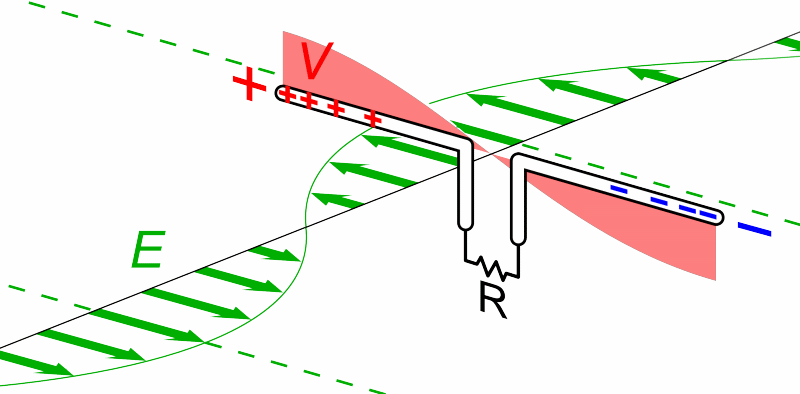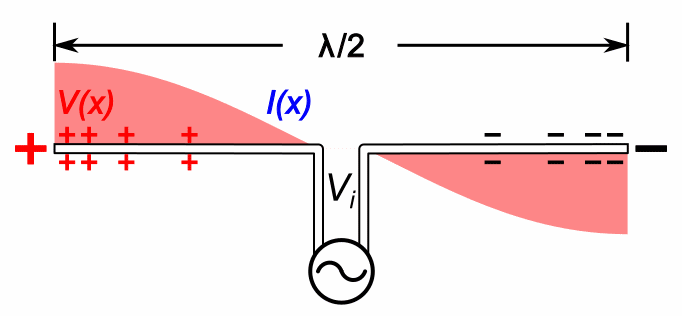A very cool thing about telecommunication is, besides how incredibly fast it advanced (in this sense it is no cooler than integrated circuit development), how much physics and information theory is involved in it. Applications of telecommunication implementation spill over to other fields, e.g. some proposed quantum computing approaches are remarkably related to telecommunication technology, e.g. microwaves and silicon photonics.
This understanding made Ciro Santilli wish he had opted for telecommunication engineering when he was back in school in Brazil. For some incomprehensible reason, telecommunications was the least competitive specialization in the electric engineering department at the time, behind even power electronics. This goes to show both how completely unrelated to reality university is, and how completely outdated Brazil is/was. Sad stuff.
Testing and Circuit for a Condenser microphone by RSD Academy (2018)
Source. Not very numerical, but shows a simple working breadboard circuit and an oscilloscope. He whistles with his mouth to get a pretty pure frequency.
That type of microphone requires a bias voltage. The circuit is in Ciro's ASCII art circuit diagram notation:
DC_9---R_10k--+--MICROPHONE--+--G
| |
+-------V------+Soundwaves on an oscilloscope by Animated Science (2015)
Source. Dude speaking to microphone. Some analysis of how different sounds look like. No circuit diagram.One encoding to rule them all, and in the darkness bind them.
Very interesting story! A predecessor to microwave transmission for trading.
How The First Ever Telecoms Scam Worked by Tom Scott (2018)
Source. Amazing how they used control signals to hide the information from officials on either side.Also wired phones don't require modulation, which likely made their development much easier than wireless voice transmission. You just send the signal as a voltage differential directly obtained from the air pressure: how the telephone works.
- www.quora.com/How-is-a-voice-transmitted-from-one-phone-to-another
- www.quora.com/How-many-wires-does-a-telephone-use/answer/Peter-Yardley-1
Basic analogue phones connected to the public exchange use two wires mainly arranged as a twisted pair to reduce noise. The voice signal is differential (the voltage in one wire equal and opposite to the other) biased above ground by 48V. Using a twisted pair reduces induced noise because the noise signal will induce an equal voltage in each wire and because the signal is transmitted as the difference the effect of the induced noise will be dramatically reduced.
Phone Intercom by Make (2014)
Source. This video illustrates will the incredible simplicity of the connection of a telephone system. Compare that to the relative complexity of wireless communication, which requires modulation.This section is about telecommunication systems that are based on top of telephone lines.
Telephone lines were ubiquitous from early on, and many technologies used them to send data, including much after regular phone calls became obsolete with VoIP.
These market forces tended to eventually crush non-telephone-based systems such as telex. Maybe in that case it was just that the name sounded like a thing of the 50's. But still. Dead.
Long Distance by AT&T (1941)
Source. youtu.be/aRvFA1uqzVQ?t=219 is perhaps the best moment, which attempts to correlate the exploration of the United States with the founding of the U.S. states.Not a telephone-based system, needing its own network, and was killed particularly by fax which is. Telex evolved from the Telegraph, which is a binary system at the physical layer.
Uses telephone lines, and therefore were still usable much much after the Internet made them obsolete, which is quite funny.
Heinrich Hertz's main initial experiment used a spark-gap transmitter. It is not something that transmits recorded sounds like voice: it only transmits noisy beeps. And as such was used for wireless telegraphy.
- a piezo igniter from a barbequeue lighter
- a more powerful home-made transformer
Hertz and Radio waves Explained by PhysicsHigh (2016)
Source. Simple schematics showing the basics of the experiments. No choice of components rationale.But now people want to send voice. How to do it?
It would not be practical without modulation: Why can't you send voice without modulation?
Basically, the antenna has to be very, very large, more comparable to wavelength. E.g. even for the higher pitches, we fall in very low frequency, so have a look at the size of some of the submarine VLF antennas! They are like football pitch sized.
To send voice and music, amplitude modulation had to be developed. And a key ingredient of this is the carrier wave.
The problem is, the carrier wave needs to have somewhat high frequencies, in the hundreds of kHz TODO why. But as you might imagine, that is hard to achieve by mechanical means such as a hand cranck like Hippolyte Pixiis alternator!
Interestingly, some of the first carrier wave generators were actually mechanical, e.g. the Alexanderson alternator.
But clearly such mechanical machines were not very scalable, and soon more electronic devices were introduced, notably the vacuum tube.
Radio Wave Properties: Electric and Magnetic Dipole Antennae by Harvard Natural Sciences Lecture Demonstrations (2020)
Source. The dude lights bulbs on an antenna made of a single piece of copper, powered with EM radiation. Amazing.As well put by Wikipedia, a radio receiver has to perform three functions on the signal from the antenna:
- filtering, so you can tune the station you care about. This filters based on the frequency of the carrier wave you want. I.e. you use a bandpass filter.
- amplification: otherwise you won't be able to hear anything if the emitter is too far away
- demodulation: this means decoding the signal based on whatever way it was encoded, notably e.g. AM/FM
The first type of device that allowed sending Morse code without wires, as opposed to the wired electrical telegraph that previously existed.
Wireless voice transmission came about with modulation.
Founder: Peter Armstrong
ruboss.com/ documents their stack, a somewhat similar choice to OurBigBook.com as of 2021, notably Next.js. But backend in Ruby on Rails. They actually managed Apollo/GraphQL, which Ciro Santilli would have liked, but din't have the patience for.
The founder/CEO Peter Armstrong www.linkedin.com/in/peterburtonarmstrong/ He looks like a nice guy.
In leanpub you write your book in a markdown variant they call Markua, marketed as "markdown for books".
TODO is there a reference implementation that runs locally for HTML output? Or the only reference implementation is closed under leanpub?
Spec: markua.com/
Articles by others on the same topic
There are currently no matching articles.


